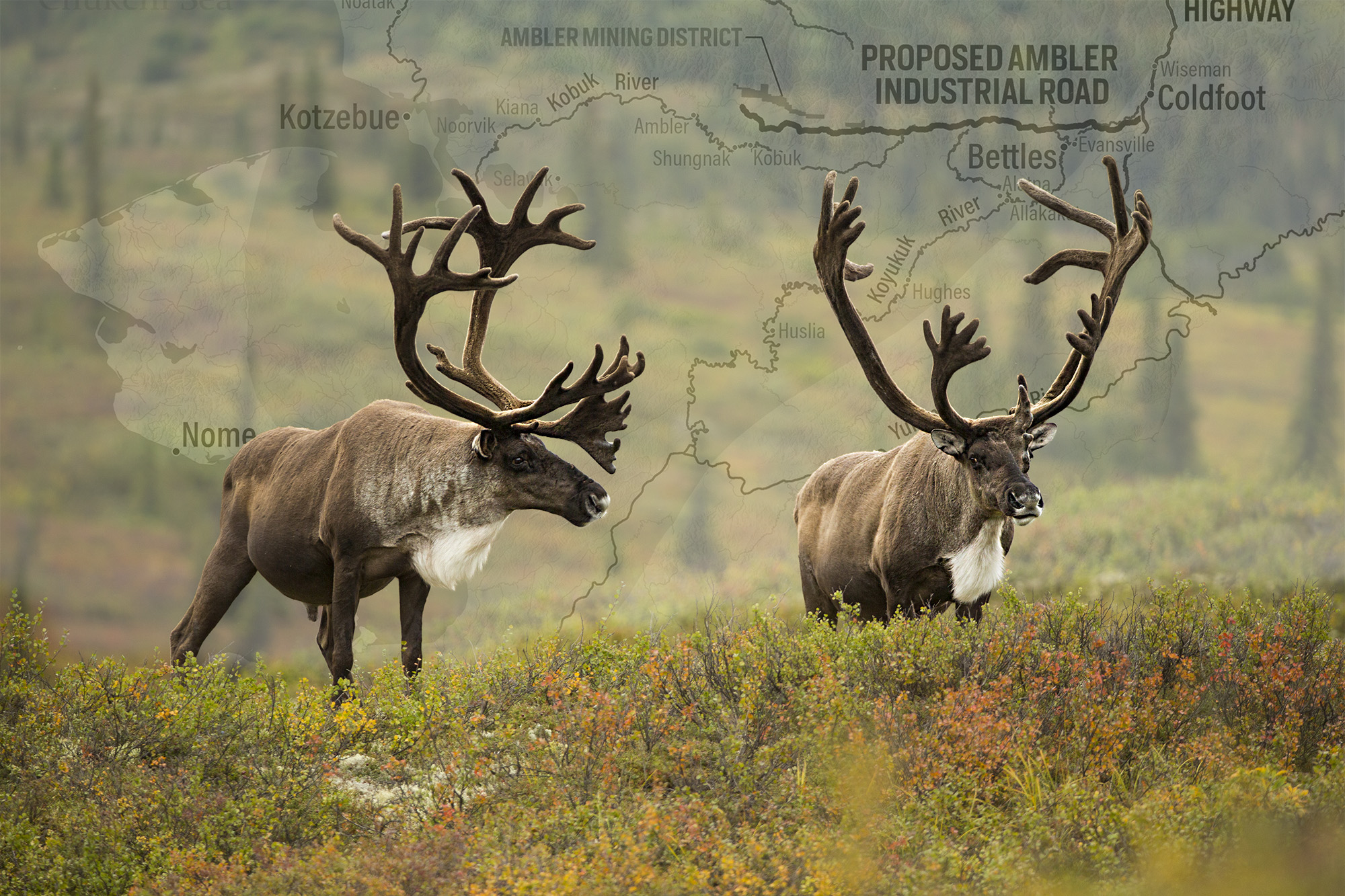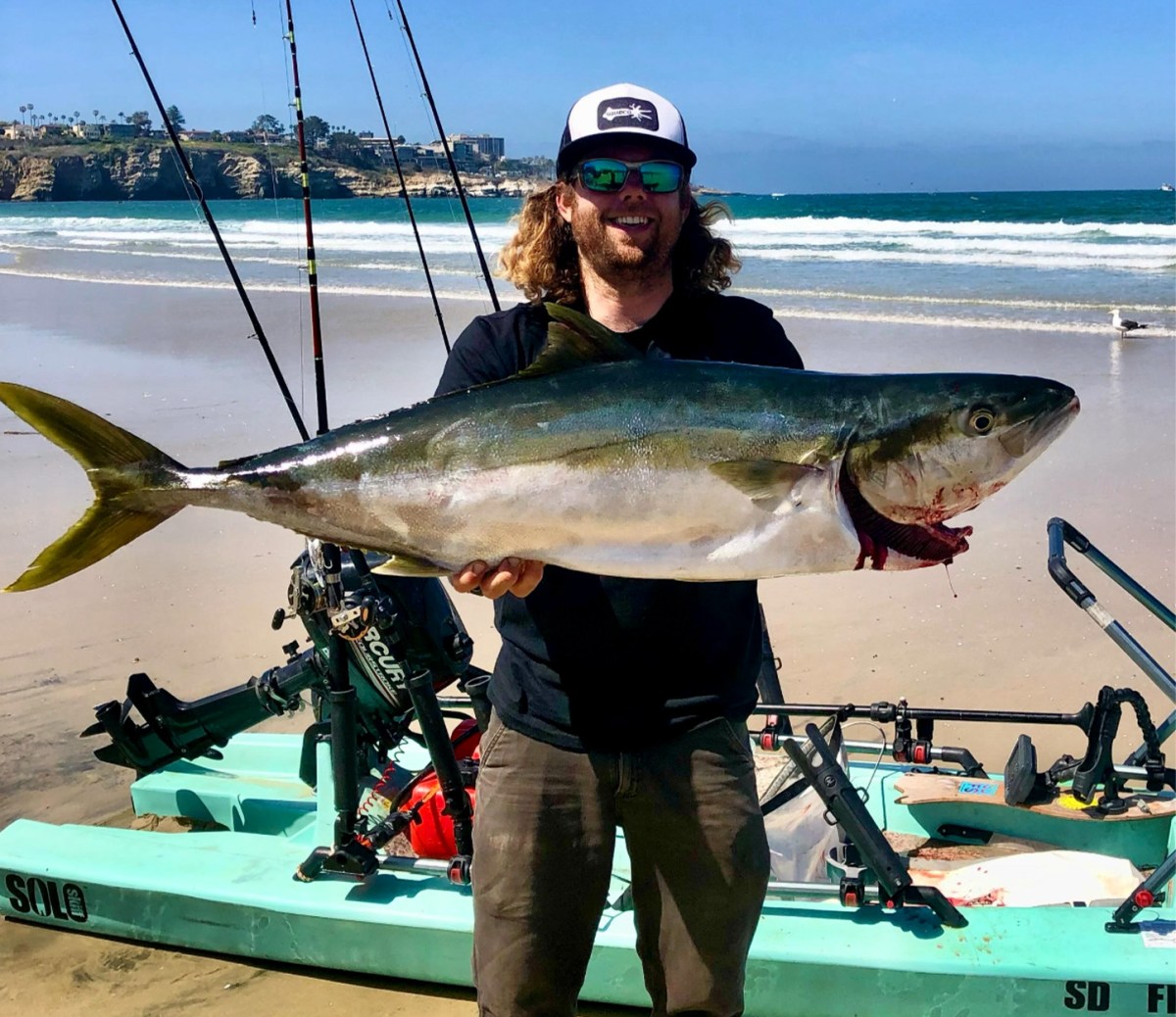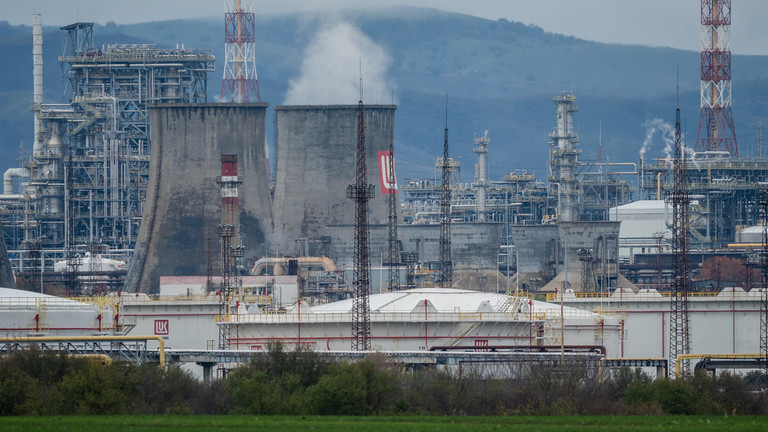The Ambler Road Project Would Jeopardize One of the Last Great Wilderness Hunts in America

“I don’t know if this will work, but I don’t think it’ll hurt.”
I hand the folding saw back to Arc and pick up the two alder boughs I’ve just cut. Through the screening leaves I see my husband raise his eyebrows, but he doesn’t object. Instead, he falls in line and we begin to creep, single-file and shielded by brush, across the valley toward a herd of caribou.
The 800 yards of tundra between us looks flat. It’s why we’re so exposed. But wading through the sock-soaking morass of sedge tussocks and sphagnum moss feels anything but level. When sentries on the fringes of the herd glance our way, we freeze, then inch forward again. (This sneaking bush ploy may sound like a Looney Tunes gag, but it has precedent.) We pick our way closer to the group, a mix of 40 cows, calves, and at least one good bull.
Eventually we close to within 80 yards of the nearest caribou and tuck into a low-slung hedge of arctic birch. The bull we’re stalking hasn’t busted us, but he’s restless. It’s early August and his sleek hide and velvet antlers are still the deep brown of early summer. He’s not massive, but his sweeping beams look plenty big to us. Arc is eager to shoot.
The only problem is the bull is now on the move, seemingly intent on pushing south. I throw up the tripod and report increasing ranges — 210, 245, 260 yards — as the bull cruises away, and Arc settles behind his rifle.
North to the Arctic
We’d flown north from the coastal town of Kotzebue the day before. Our pilot pointed his 1961 Cessna 185 Skywagon into the spitting rain and civilization fell away behind us. We sped over brilliant green wetlands, braided streams, and glacial gravel bars of northwest Alaska. Human sign — shanty fish camps, sunken skiffs, fishermen in motor boats, a trio of hunters beside their tent — became fewer and farther between.
Just as I was starting to feel we had crossed into true wilderness, the slash of a wide gravel road in the tundra below jolted me back. It’s a 52-mile haul road that connects one of the world’s largest zinc mines, the Red Dog Mine, to its sea port. A few minutes later thoughts of the road vanished as our pilot, Jett Selman, threw an elbow into my ribs.
“There’s your caribou!”
And there they were. The leading edge of the continent’s largest land migration surged beneath us. Inky blots of caribou — bedded, feeding, sparring, walking, running caribou — were streaming together, splitting and melting away and swelling once more beneath the Cessna’s belly.
“Holy shit,” he added after a moment. “Look at them all.”
A seasoned bush pilot, Selman crisscrosses the Arctic during the height of hunting season. It takes, I gather, quite a few caribou to get him worked up.
Of course, what seems like an endless migration is anything but. These particular caribou belong to the Western Arctic Caribou Herd, once the largest of Alaska’s 32 herds and now at a third the size of its known peak in 2003. It’s not at an all-time low, but declines have triggered stricter hunting restrictions and changes to traditional migratory routes that, in turn, affect harvest opportunities. The reason for the herd’s sharp decline is at the heart of heated arguments that have played out across Alaska for years. Theories range from the perfectly normal boom-and-bust cycle of caribou populations to the global culprit of climate change.
But one looming threat is uniting traditionally polarized groups: the proposed Ambler Road. The push to build the controversial 211-mile private industrial corridor through one of the last great intact wildernesses of the world, most folks agree, won’t do these caribou any favors. More likely its construction and related development for foreign-owned mines would threaten an already-vulnerable herd suffering from death by a thousand cuts. The cascading social and ecological damage, many locals worry, would be irreversible.
We kept flying north, past the caribou. The public ground beneath us, Unit 23, was closed to anyone but local subsistence hunters. That excludes most Alaskans, and certainly two Midwestern interlopers.
Instead, Selman delivered us to the North Slope of the Brooks Range, 150 miles north of the Arctic Circle. After making three earnest attempts to land on the east bank of the Kukpowruk River — the side with all the caribou — he touches down to the west. Before he left, I eyed the stream and asked about changing river levels in this country.
“If it rises more than 4 feet,” he said, turning for the cockpit, “maybe let us know.”
The Cessna buzzed as it climbed to the stormy sky, and disappeared.
Roads and Caribou
Although planes and vehicles can zip right over the Red Dog Mine road, the Western Arctic Herd has a more difficult time navigating it.
When Jim Dau first started sifting through GPS collar data from the Red Dog road, he was astonished to discover the haul road was delaying caribou migrations in ways no one had noticed before.
Dau, now retired, served as the lead Western Arctic Herd biologist from 1988 to 2016. His epiphany arrived more than a decade ago, when an analysis of 2011 data uncovered that about a quarter of the WAH caribou had encountered the Red Dog road that year. And, on average, it took collared caribou a month to cross it. The reason caribou are skittish of roads is not so much the sight of bare gravel, Dau suggests, but the constant vehicle activity. The mine operates 24 hours a day, with an average of one ore truck rumbling past every 15 minutes.
Worse, many caribou needed several attempts to cross the road, often bouncing off and retreating as far as 100 miles north before turning south to try again, or traveling many miles east to avoid the road altogether. After crossing, Dau says, delayed caribou “turned on the afterburners” to catch up with animals that had already migrated south.
While these effects didn’t immediately affect mortality or recruitment the following year, Dau says delayed and diverted migrations certainly affect hunters, particularly Native communities who subsist on the caribou as their primary source of red meat, among other uses.
While Dau’s analysis studied a relatively small sample size of caribou, a study published this summer analyzing WAH cow collar data from 2009 to 2024 found similar reactions to the Red Dog and Dalton Highway haul roads; 62 percent of all caribou that encountered roads altered their behavior.
“We know an awful lot about how roads impact wild populations. We don’t know a hell of a lot about how to minimize or prevent those things from happening,” says Dau, who is also concerned about habitat fragmentation. “Some impacts of roads are inevitable, and I think some are irreparable.”
The proposed Ambler Road would impact the Western Arctic Herd in many subtle ways that Dau suspects will cause that sort of permanent damage. At 211 miles, the proposed corridor is four times as long as the Red Dog road, with double the activity from ore trucks hauling ore from mines to port. The road would provide private access to one of the largest undeveloped copper-zinc mineral belts in the world, and at least four major deposits have been identified in the Ambler Mining district. It also comes with a load of infrastructure, including 49 bridges, four maintenance stations, three airstrips, employee housing, and communication towers.
While proponents of Ambler often point to the Dalton Highway as an example of how roads and caribou can coexist, it’s a less useful comparison than the Red Dog road. While caribou do indeed seek refuge from insects on roads, usually in July, says Dau, those same animals avoid those roads in June. Meanwhile, the Dalton Highway runs north-south; the Ambler Road would run east-west at the bottom of the Western Arctic Herd’s winter range, intersecting a much broader swath of migratory routes.
Related: A DIY Bowhunt for Caribou Along Alaska’s Haul Road
“The Ambler Road is probably not the death knell of the Western Arctic Herd, and maybe not even [potential additional spur] roads all the way out to the coast. But is the Western Arctic Herd ever going to be able to recover to a half million animals again? I don’t know, but it scares the hell out of me to risk it,” says Dau. “There are just so many unknowns. I don’t think it’s just a coincidence that you look at the biggest caribou herds in Northwest Alaska, and they tend to be in the biggest areas that don’t have a lot of roads.”
At the end of Dau’s tenure at Alaska Game and Fish, the state stopped producing biannual reports on the Western Arctic Herd, which include key harvest trends and herd health updates. That loss is “a real shame,” according to Dau, and why, in many ways, the health of this particular herd is so hard to pin down.
“No caribou herd uses 100 percent of its range. You can go to areas where you just can’t find any caribou. But over the course of decades? They use all of their range. Every bit of it.”
—Jim dau
“In any one year, no caribou herd uses 100 percent of its range. You can go to areas where you just can’t find any caribou,” says Dau. “But over the course of decades? They use all of their range. Every bit of it. So when you start building these linear structures like these roads [in their winter range], and you start creating these big sprawling industrial complexes with blasting going on and big heavy trucks that’ve got to get product [out], it really changes what these caribou are going to experience in their traditional range.”
And this predicted level of disruption assumes that everything goes according to plan. It doesn’t account for the mines development themselves, catastrophic failures, or pollution. For example, moss studies along the Red Dog Mine road have identified elevated heavy metal contaminates from “fugitive dust” during ore transport, and forever chemicals have tainted grayling and whitefish in at least one lake along the Dalton Highway.
“It’s impossible to stop nature,” says Clarence Wood-Griepentrog, an Inupiaq from Ambler who now lives in Kotzebue. “So all these engineers and the people making the plans and drawing up the blueprints? Look at several past years. We have very rainy summers and falls, and our rivers are blown out bank to bank, flooding a lot of times. And what do you get with mining? You get tailing ponds. Polluted water is going to make it into our tributaries. It’s one hundred percent going to get in. I don’t care who they put on the job. You can’t beat nature.”
Three Good Bulls
The bull is at 350 yards now and still on the move. Arc wisely declines to shoot, but before long another pair of bulls appears from behind a hillock. They are quartering hard as they catch up to the first bull. Again, Arc tracks the lead bull in his scope as I relay their ranges until, at last, the pair vanish behind a swell in the tundra 400 yards away.
The longer we wait, the farther the bulls will get. Arc and I decide to try slipping closer, a tall order under the watchful eyes of the cows, calves, and young bulls off to our left. There’s not a scrap of cover, and they start to tense. We cannot hope to impersonate a bush again, not at this oblique angle. But as a few more cows rise to their feet, I notice how dark all those antlers look against the sky (cows have antlers, too).
“I have another idea,” I whisper, turning to Arc. “This one almost definitely won’t work, but what do we have to lose?”
He’s game. I tell him to stick close, then flip my tripod upside down, and — holding it like an absurd black tophat — march toward the mound between us and the trio of shooter bulls.
“What the hell are you doing?” Arc sounds half alarmed, half amused.
“Pretending to be a caribou. Stay close.”
(I learned this tactic from a professional hunter in Namibia, who once braced spindly V-shaped shooting sticks on his head like a gemsbok and swayed his way toward the real thing. Apart from shooting, my job was, as he put it, to be the ass.)
The herd remains alert; a few resume feeding. We’re miraculously covering ground when the wind swirls, and a dozen cow heads turn toward us. Running as best we can across the tundra now, we splash through the bog and, panting, close the final yards. The cows are in a tight knot, bunched and ready to run.
In seconds Arc is stable on the tripod again. The three bulls are looking over their shoulders now, stacked like cards at 215 yards. Their antlers seem identical. When one finally steps forward and turns, broadside, he doesn’t hesitate. The heart-shot bull runs 40 yards before a second shot neatly folds him.
The herd settles and begins feeding again a few hundred yards away. Arc’s adrenaline, meanwhile, is spiking. He can’t stop talking.
Those three bulls were hardly record-book animals, but they might as well be. Standing together they looked both regal and utterly primal all at once. The effect does not diminish when we approach. One motionless antler juts above the tundra. Arc puts a hand on one slippery main beam, its charcoal hide, the silky nose. His expression is one of awe and he is, at last, rendered speechless.
Migrating Expectations
Some 15 years ago, the former mayor of Kotzebue witnessed a phenomenon few people will ever experience. It was the first week of October and Lew Pagel had given up on caribou hunting. The migration was late, so he’d departed to his trapping cabin to cut firewood. Through the snow and freezing rain, he glimpsed movement — a caribou. Pagel grabbed a rifle and, cresting a ridge, was astonished to discover tens of thousands of caribou milling across the tundra.
“It was the most majestic thing I have ever seen in my entire life. I crawled on my belly across the tundra into the middle of the herd and laid there for an hour, just watching them.”
He ended up shooting two big bulls and has never experienced a mass migration there since. The delayed migration of caribou near Kotzebue and the surrounding villages, however, has become the norm. (In 2025, locals reported caribou arrived more on their historic timeline, though no one is quite sure why.)
“People here used to be able to set their watch by the caribou herd coming through,” says Pagel, currently a chiropractor in Kotzebue and sheefish guide on the Kotzebue Sound. “It would come through late August and early September a long time ago and now we’re seeing migrations in late October and early November. Most years it seems like they’re walking across the ice rather than swimming across the water.”
The delayed migration may not seem like a big deal to hunters in the Lower 48, but changing weather conditions — snow, freeze up — directly impact hunters’ ability to access the migrating herd.
“All these hunters not from here have deep pockets, money for gas — they have options,” says Wood-Griepentrog. “And a lot of us residents don’t. We have to work with what we’ve got.”
A commercial fisherman and substitute teacher, Wood-Griepentrog doesn’t own a boat so he uses a snowmachine to access caribou. He relies on the tundra for about 70 percent of his diet, which also includes ducks, geese, moose, fish, and berries.
Dau, the retired caribou biologist, has also struggled to kill caribou within reasonable distance of his home in Kotzebue. After shooting a single caribou in just one of the last four years, the 73-year-old has shifted his efforts to moose hunting. So have many other locals.
Other villages farther from Kotzebue, however, particularly to the east, have benefited from shifting migration patterns as herds arrive sooner or more reliably than in the past. And as Dau and other Alaskans have pointed out, even herds at their peak don’t always show up in the same place, year after year.
Still, he says, the Ambler Project “will have huge social impacts on these subsistence economies that have been thriving for millennia. The other thing is, it makes a bad situation with climate change even worse.”
The changing climate is the only explanation Dau can identify for the 65 percent global decline of caribou in the last few decades. And Alaska, abundant research shows, experiences accelerated effects from climate change. Caribou in particular are vulnerable to freeze-ups from winter rains, which can fall during warming periods and then, when temperatures plummet again, create sheets of ice that cover the tundra, covering vital forage and wiping out caribou for hundreds of miles, from the youngest calf to the strongest bulls.
Related: Can Sheep Hunting in the Yukon Survive Another Century?
“I just can’t stress enough the ecological importance of the Western Arctic Caribou herd for sheep and moose and brown bears,” says Dau. “When you’ve got half a million animals, they have the ability to impact vegetation, predators, scavengers, other prey species. Caribou take so much heat off moose and Dall sheep. I think there’s a reason why, out here, sheep aren’t bouncing back. They just don’t have caribou like they used to and predators are forced to take moose and sheep now.”
Student of the Tundra
If stalking Arc’s bull was an exercise in seeing what we can get away with, my hunt hinges on understanding the caribou’s habits. We learn their daily rhythms, their preferred browse, when they bed or descend into the valley, and where they cross the river.
In some ways hunting caribou is more like hunting migrating ducks than big game. The small herds using our valley today will be gone tomorrow. By watching them and studying their travel routes, I can anticipate where the next migrators will appear. And you must have faith that the next group of bulls will appear. Because those that have gone are gone for good.
We explore the bald, mile-distant ridges the caribou have been following south. Each time we check a hillside pocket, I cannot resist pushing farther north to check the next one, and the next. Every caribou we see is a cow, calf, or young bull, and I start to realize how few and far between the bachelor herds are. The longer we hunt, the fewer caribou filter through.
The fourth morning finds me waiting at a river crossing that the caribou have been using regularly. I’ve spotted a bachelor herd on the other side and I make my best guess about where they will cross. They are far from the biggest bulls I’ve seen, but I feel a sense of urgency today. If I get a chance, I’ll shoot one.
When Arc saw me off this morning, I could not cross the river; it had swollen overnight, the current swift and muddy. The river tugs at the bulls when they swim it, one by one, but it’s not even an inconvenience to them. Willows obscure them on the wide gravel bar below my position, but I hear splashing. I am in position and waiting when three sets of velvet antlers rise out of the brush 15 yards in front of me. I am expecting it, but the sight nevertheless raises the hair on my neck. Five bulls now surge up the bank another 15 yards and turn to look at me. I pick out the biggest and shoot him at bow range.
The bull leaps forward, sprinting in a sharp U-turn, curving away and plowing right back toward the river. My composure evaporates as I imagine him escaping into the rising river and dying on the opposite bank or — worse — being swept downstream. I get off a second shot just as he plows out of sight. I’m unsure if it strikes earth or caribou.
I scramble across the willow-choked bluffs, checking each gully that funnels to the river. At last I peer into the fifth crevice and spot the huge gray belly of my bull, nose buried in the willows. He died a few yards short of tumbling into the current, and I am grateful.
The sunshine is warm and the breeze strong, and I sit beside my bull for a long time before unsheathing my knife. The bulls that crossed the river with mine are already feeding again. They watch me — curious, unafraid. Some hunters call caribou dumb, but I don’t think that’s right. To hunt an animal is to get to know it, or to begin to, anyway. These caribou are aware of my presence and so, in a way, they know me, too. Maybe they also know that some of their kind will be killed by hunters, and wolves, and bears, and that’s just how things go on the tundra.
Soon the little group of bulls continue on their way, doing their own small part in this vast migration, and I continue on mine.
Opportunity Costs
Last year the BLM blocked Ambler, finding it too risky to Alaska’s natural resources. The second Trump administration reopened it, as part of its mission to develop resources on Alaska public lands and ramp up mineral production for American energy independence. Trilogy Metals, a Canadian- and Australian-owned company, plans to export Ambler zinc to Asia. The other primary minerals identified for extraction, like copper and gold, aren’t currently considered “critical” (though that may change).
Of course, many Alaskans support Ambler. Politicians are pushing for the jobs it will bring, along with AIEDA, the state agency mandated to expand Alaska’s economy. The BLM estimated the cost of the road at $350 million in 2018, with annual operations and maintenance costs between $8 and $10 million. Those figures are likely outdated, and scoping meetings in 2019 put the cost closer to $1.2 billion before key infrastructure (and inflation).
The state estimates building the Ambler Road would provide an average of 360 jobs during the construction period, and up to 81 jobs for road operations and maintenance. Developing mines would open more jobs.
“It’s an opportunity for jobs, but at what cost?” says Pagel, the Kotzebue fishing guide whose livelihood depends, in part, on clean water and healthy sheefish. “And we haven’t seen any legitimate information that shows Ambler will provide a large number of jobs for local people. That’s the toss up — jobs for local people or preservation of one of the largest untouched pieces of land on the planet.”
Some Native communities have thrown their support behind Ambler, and two key Native corporations must sign off to allow road construction and development on their lands. (Alaska Native Corporations are Alaska’s alternative to the tribal reservations of the Lower 48; members are considered shareholders.)
Native support for Ambler varies. The most recent survey by the NANA corporation found that 67 percent of surveyed Iñupiat shareholders were opposed to or unsure of Ambler. Fifty nine percent opposed it outright, even if all of NANA’s development requirements were met. The Red Dog Mine, by comparison, has overwhelming Native support (above 80 percent) for its economic returns to the region. (Some sources report 82 percent of Alaska-wide public-hearing comments opposed the road, but we could not verify that figure.)
NANA and Doyon, which represents Natives of Athabaskan descent, have distanced themselves from the project in 2024 and 2023, respectively. Still, those corporations have expressed ongoing interest in developing minerals.
“They’re selling their souls and damning the rest of ours,” says Wood-Griepentrog. “It really burns to see people fighting so hard for something so ugly as the Ambler Road.”
Troubled Waters
Arc and I are hauling the first load of meat when we discover the land bridge to our riverside camp is gone. Instead, a wide channel has risen around it, forcing us to slosh across. The runway is completely underwater. We dump meat and I message Selman as we hurry back to the quartered bull.
By the time we return with the second and last load, the Kukpowruk is flowing into camp. We do the only thing we can: move 100 yards back into a thick stand of willows.
I ferry gear as Arc chops a clearing for the tent. We battle brush and frigid water, hauling gear rented from our transporter, which was never intended to be carried far: two Alaskan Guide tents, cots, chairs, a Rubbermaid kitchen box, a trash bag of dehydrated meals, plus all our gear and meat. We aren’t panicking, but we are moving as fast as we can. Temps drop into the low 40s at night, with humidity as high as 85 percent. It’s raining steadily and we’re already drenched from the rising river. If we can’t establish a dry shelter soon, we’ll be in real trouble, though neither of us needs to say this aloud.
By the time we get camp set up we realize we must move again, to even higher ground. It takes hours and a dozen trips to bushwhack through the maze of willow guarding the river. Their towering, grasping branches are locked so close together that, at times, my feet come off the ground as I squeeze between them. More than once I trip spectacularly on a root, slamming face-first into the ground. Every leaf and branch is soaked from the rain, which in turn soaks our gear and meat as we force each awkward load through the branches, too. We splash through a rising moat and, as a fun final obstacle, climb every item 30 vertical feet onto the mud-slick bluffs above.
By 3 a.m. we drop into the tent. My toes and fingers are numb, my muscles ache, and I may never feel dry again. But we’re safe from the rising river, and something like euphoria sets in.
It rains all of the next day. The valley is blown out beneath us, both our previous camps completely submerged in roiling floodwaters. There is not a caribou in sight. Arc bails out the tent with an enamel coffee mug and a wool sock, and cooks fresh tenderloin for dinner.
Read Next: Welcome to the New, Uncertain Era of DIY Sheep Hunting
Three days from now, the river will drop enough for the Cessna to land. Back in Kotzebue, we’ll see dozens of fellow traveling hunters with their own filthy gear, coolers of meat, and stories to tell. For us, it has been an adventure in the truest sense: unforgettable, hazardous, exhilarating. We will tell our buddies about our hunt and urge them to plan their own, before the opportunity disappears.
Meanwhile the local hunters of Kotzebue and surrounding villages will wait for the caribou herds to arrive, as they have waited for generations. And the caribou will wait to discover if an industrial corridor will cut through their own travel corridors, one more obstacle to the greatest migration on the continent.
Read the full article here









